UWB Positioning Algorithm Based on Fuzzy Inference and Adaptive Anti-NLOS Kalman Filtering
Abstract
:1. Introduction
2. A Ranging Error Mitigation Algorithm for CIR Signal Characteristics Based on Fuzzy Inference
2.1. Theory of the Algorithm
2.2. Implementation of the Fuzzy Inference System
2.2.1. Selection of Structure and Membership Function of the Fuzzy Inference System
2.2.2. Determination of Fuzzy Sets and Fuzzy Rules
3. Adaptive Anti-NLOS Error KF Algorithm
3.1. KF Algorithm
- (1)
- One-step prediction
- (2)
- Covariance matrix of estimated errors
- (3)
- Gain matrix
3.2. Anti-NLOS KF Algorithm and Its Improvement
4. Positioning Algorithm Based on Fuzzy Inference and Adaptive Anti-NLOS KF
4.1. Adaptive Anti-NLOS KF Positioning Algorithm
4.2. Positioning Algorithm Combining Fuzzy Inference with Adaptive Anti-NLOS KF
5. Experimental Results and Analyses
5.1. Architecture of the Positioning Experiment System
5.2. Static Positioning Experiment
5.3. Dynamic Positioning Experiment
6. Conclusions
- (1)
- In terms of the decreased positioning accuracy caused by the changes in NLOS errors due to UWB mobile node positioning, a UWB node positioning algorithm combining fuzzy inference with adaptive anti-NLOS KF was proposed in this paper. It classified the CIR signal characteristics by establishing fuzzy rules, adjusted the innovation value based on the change in the difference between the innovation and its variance in the KF algorithm, recognized and mitigated the NLOS errors and substituted the positioning estimation data into the LS positioning algorithm for node position estimation.
- (2)
- Static and dynamic experiments were conducted to verify the positioning algorithm based on fuzzy inference, the adaptive anti-NLOS KF positioning algorithm and the positioning algorithm combining fuzzy inference with adaptive anti-NLOS KF. In the static positioning experiment, the probability of producing an error range of less than 19.1 cm by the positioning algorithm combining fuzzy inference with adaptive anti-NLOS KF was 0.93, which was much better than the positioning algorithm based on fuzzy inference and the adaptive anti-NLOS KF positioning algorithm. In the dynamic positioning experiment, compared with the adaptive anti-NLOS KF positioning algorithm, the RMSE was reduced by 43.31% in overall positioning. Furthermore, compared with those of the positioning algorithm based on fuzzy inference, the RMSEs in overall positioning were lowered by 12.89%. The experimental results demonstrated that the static positioning estimation and dynamic positioning trajectory of the positioning algorithm combining fuzzy inference with adaptive anti-NLOS KF were closer to the actual node position, the positioning performance was significantly improved, and the positioning accuracy was increased.
- (3)
- Because only three CIR signal characteristics (FPPL, RSSI and RT) were selected, the positioning accuracy of the positioning algorithm based on fuzzy inference might occasionally be significantly reduced. In the future, more CIR signal characteristics can be considered to improve the estimation accuracy of NLOS errors, thereby improving the positioning accuracy.
Author Contributions
Funding
Institutional Review Board Statement
Informed Consent Statement
Data Availability Statement
Conflicts of Interest
References
- Shi, D.Q.; Mi, H.Y.; Collins, E.G.; Wu, J. An Indoor Low-Cost and High-Accuracy Localization Approach for AGVs. IEEE Access 2020, 8, 50085–50090. [Google Scholar] [CrossRef]
- Zhou, N.; Lawrence, L.; Bai, R.B.; Terry, M. Novel prior position determination approaches in particle filter for ultra wideband (UWB)-based indoor positioning. Navigation 2021, 68, 277–292. [Google Scholar] [CrossRef]
- Typiak, R.; Rykała, Ł.; Typiak, A. Configuring a UWB Based Location System for a UGV Operating in a Follow-Me Scenario. Energies 2021, 14, 5517. [Google Scholar] [CrossRef]
- Su, M.; Yang, Y.; Jiang, J. BeiDou system satellite-induced pseudorange multipath bias mitigation based on different orbital characteristic for static applications. IET Radar Sonar Navig. 2019, 14, 242–251. [Google Scholar] [CrossRef]
- Ala’a, A.; Gabriel, W.; Moayad, A. Machine learning-based indoor localization and occupancy estimation using 5G ultra-dense networks. Simul. Model. Pract. Theory 2022, 118, 102543. [Google Scholar]
- Safar, M.A.; Halgurd, S.M. A Comprehensive Review of Indoor/Outdoor Localization Solutions in IoT era: Research Challenges and Future Perspectives. Comput. Netw. 2022, 212, 109041. [Google Scholar]
- Sun, J.; Shang, J.N.; Liu, X.H.; Xu, H.L.; Wu, F. An Improved Weighted KNN Location Algorithm Based on Fuzzy Reasoning. Chin. J. Sens. Actuators 2020, 33, 882–888. [Google Scholar]
- Li, Y. Research on Indoor Location Method Based on UWB/INS Combination; Harbin Engineering University: Harbin, China, 2019. [Google Scholar]
- Sandra, D.; Igor, S.; Milica, J.; Goran, L.D. Multi-algorithm UWB-based localization method for mixed LOS/NLOS environments. Comput. Commun. 2022, 181, 365–373. [Google Scholar]
- Zhang, B.; Chen, X.; Liao, Y.N.; Tian, Q. UWB/INS indoor positioning algorithm based on DL-LSTM. Transducer Microsyst. Technol. 2021, 40, 147–150. [Google Scholar]
- Tian, G.L.; Zhang, L.J.; Li, Z.Y. UWB/INS integrated location method based on improved robust Kalman filter and SVR. Electron. Meas. Technol. 2022, 45, 79–84. [Google Scholar]
- Hu, Q.; He, T.J.; Jia, T.; Li, H.; Tang, Y.J. UWB/GPS combination positioning method. J. Nanjing Univ. Sci. Technol. 2018, 42, 76–81. [Google Scholar]
- Zhang, C.C. Research on Indoor Combined Positioning Based on Wi-Fi/UWB/Barometer; Southeast University: Nanjing, Chian, 2018. [Google Scholar]
- Liang, Y.; Zhang, Q.D.; Zhao, N.; Li, C.M. Indoor location method based on UWB and inertial navigation fusion. Infrared Laser Eng. 2021, 50, 293–306. [Google Scholar]
- Zhang, G.L.; Deng, Z.L.; Wen, L.; Ke, H.; Jiao, J.C. An UWB location algorithm for indoor NLOS environment. In Proceedings of the 2018 Ubiquitous Positioning, Indoor Navigation and Location-Based Services (UPINLBS), Wuhan, China, 22–23 March 2018; pp. 1–6. [Google Scholar]
- Liu, T.; Xu, A.; Sui, X. Adaptive Robust Kalman Filtering for UWB Indoor Positioning. Chin. J. Sens. Actuators. 2018, 31, 567–572. [Google Scholar]
- Huang, B.; Li, W. Location Algorithm Based on Particle Filtering and Maximum Likelihood for TDOA under LOS_NLOS Conditions. Comput. Simul. 2022, 39, 481–489. [Google Scholar]
- Chen, H.; Wang, G.; Ansari, N. Improved robust TOA-based localization via NLOS balancing parameter estimation. IEEE Trans. Veh. Technol. 2019, 68, 6177–6181. [Google Scholar] [CrossRef]
- Barral, V.; Escudero, C.J.; García-Naya, J.A. NLOS classification based on RSS and ranging statistics obtained from low-cost UWB devices. In Proceedings of the 2019 27th European Signal Processing Conference (EUSIPCO), A Coruña, Spain, 2–6 September 2019; pp. 1–5. [Google Scholar]
- Stefano, M.; Wesley, M.G.; Henk, W.; Moe, Z.W. NLOS identification and mitigation for localization based on UWB experimental data. IEEE J. Sel. Areas Commun. 2010, 28, 1026–1035. [Google Scholar]
- Yang, X. NLOS mitigation for UWB localization based on sparse pseudo-input Gaussian process. IEEE Sens. J. 2018, 18, 4311–4316. [Google Scholar] [CrossRef]
- Sunil, K.M.; Muhammad, A.; Faroq, A.; Kemal, T. Empirical Based Ranging Error Mitigation in IR-UWB: A Fuzzy Approach. IEEE Access 2019, 7, 33686–33697. [Google Scholar]
- Che, F.; Ahmed, Q.Z.; Khan, F.A.; Lazaridis, P.I. Anomaly Detection Based on Generalized Gaussian Distribution approach for Ultra-Wideband (UWB) Indoor Positioning System. In Proceedings of the 2021 26th International Conference on Automation and Computing (ICAC), Portsmouth, UK, 2–4 September 2021; pp. 1–5. [Google Scholar]
- Wang, C.Y.; Wang, J.; Ning, Y.P.; Yu, H. Study of niose reduction method for ultra wideband positioning. Sci. Surv. Mapp. 2019, 44, 175–181. [Google Scholar]
- Yu, K.G.; Wen, K.; Li, Y.B.; Zhang, S.; Zhang, K.F. A novel NLOS mitigation algorithm for UWB localization in harsh indoor environments. IEEE Trans. Veh. Technol. 2018, 68, 686–699. [Google Scholar] [CrossRef]
- Jia, Y.W.; Duan, X.; Zhang, H.M.; Duan, T.Y.; Xu, Q.G.; Mao, H. Design optimization method of Mamdini type fuzzy controller applied to research reactor. At. Energy Sci. Technol. 2021, 55, 1091. [Google Scholar]
- Ge, L. Research on High Precision Indoor Location and Clock Synchronization Algorithms Based on UWB; Beijing University of Posts and Telecommunications: Beijing, China, 2019. [Google Scholar]
- Li, J.Y. Design and Implementation of RSSI Indoor Positioning Tracking Algorithm Based on Adaptive Kalman Filter; Southeast University: Nanjing, China, 2019. [Google Scholar]
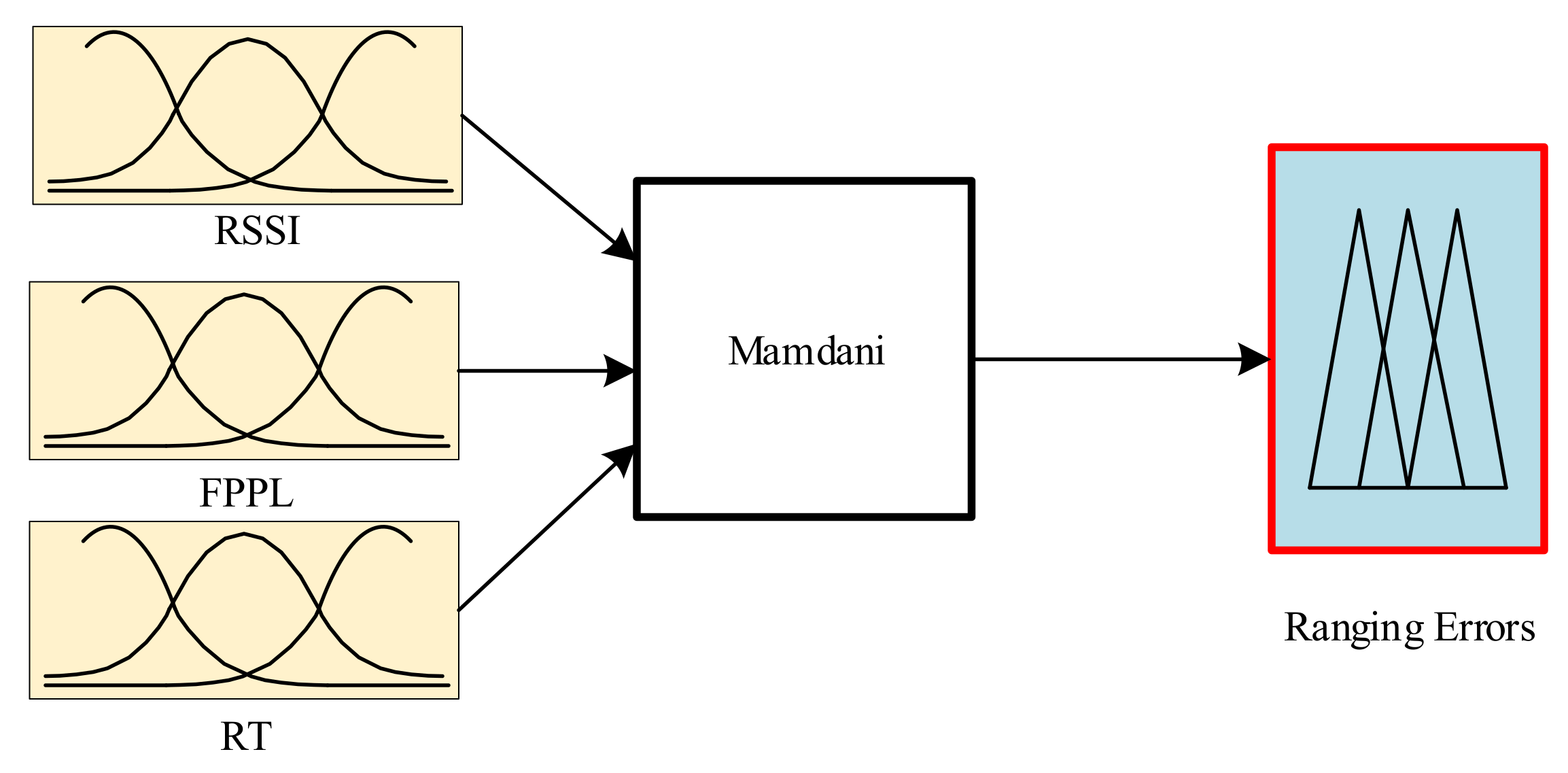
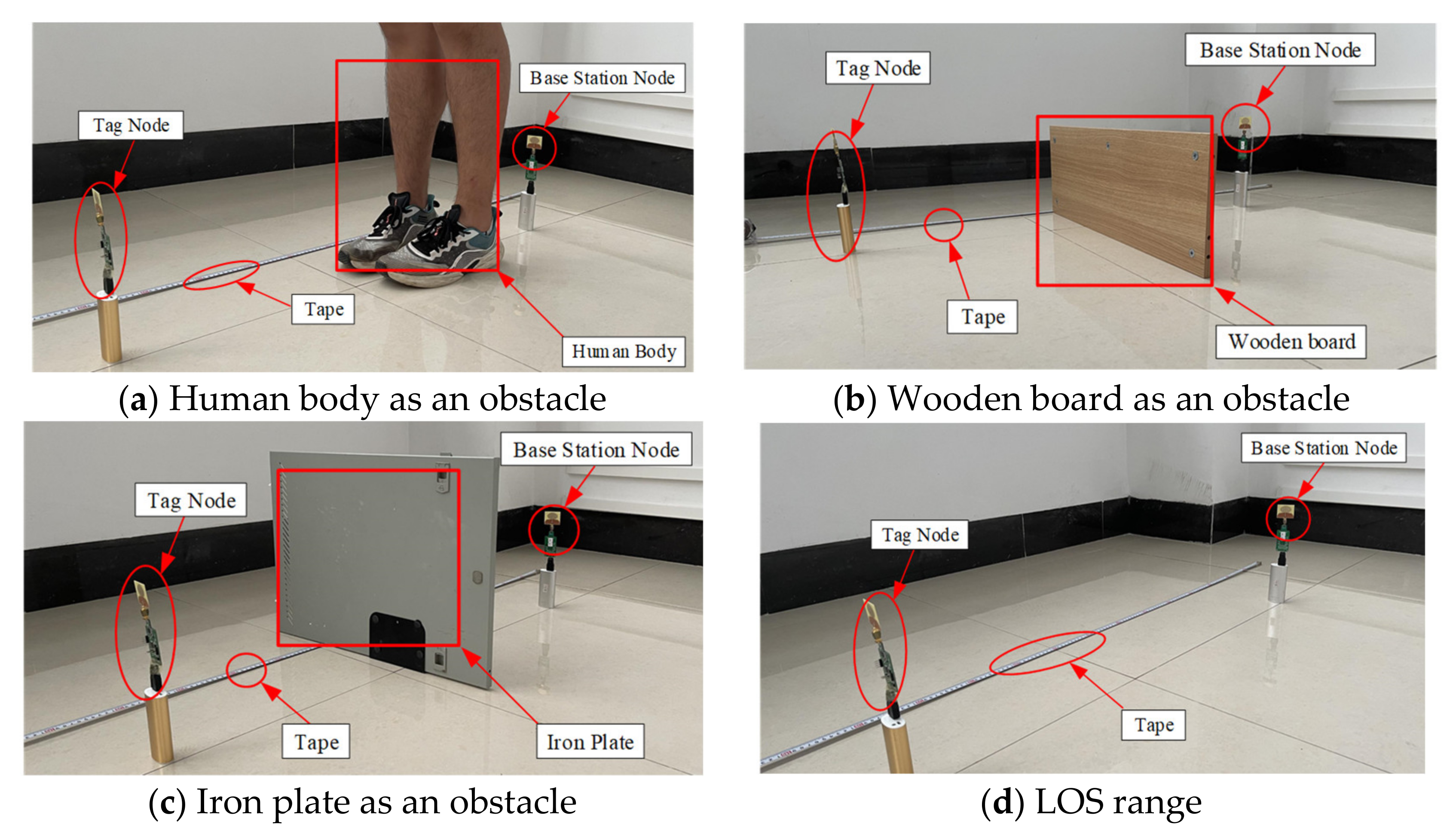
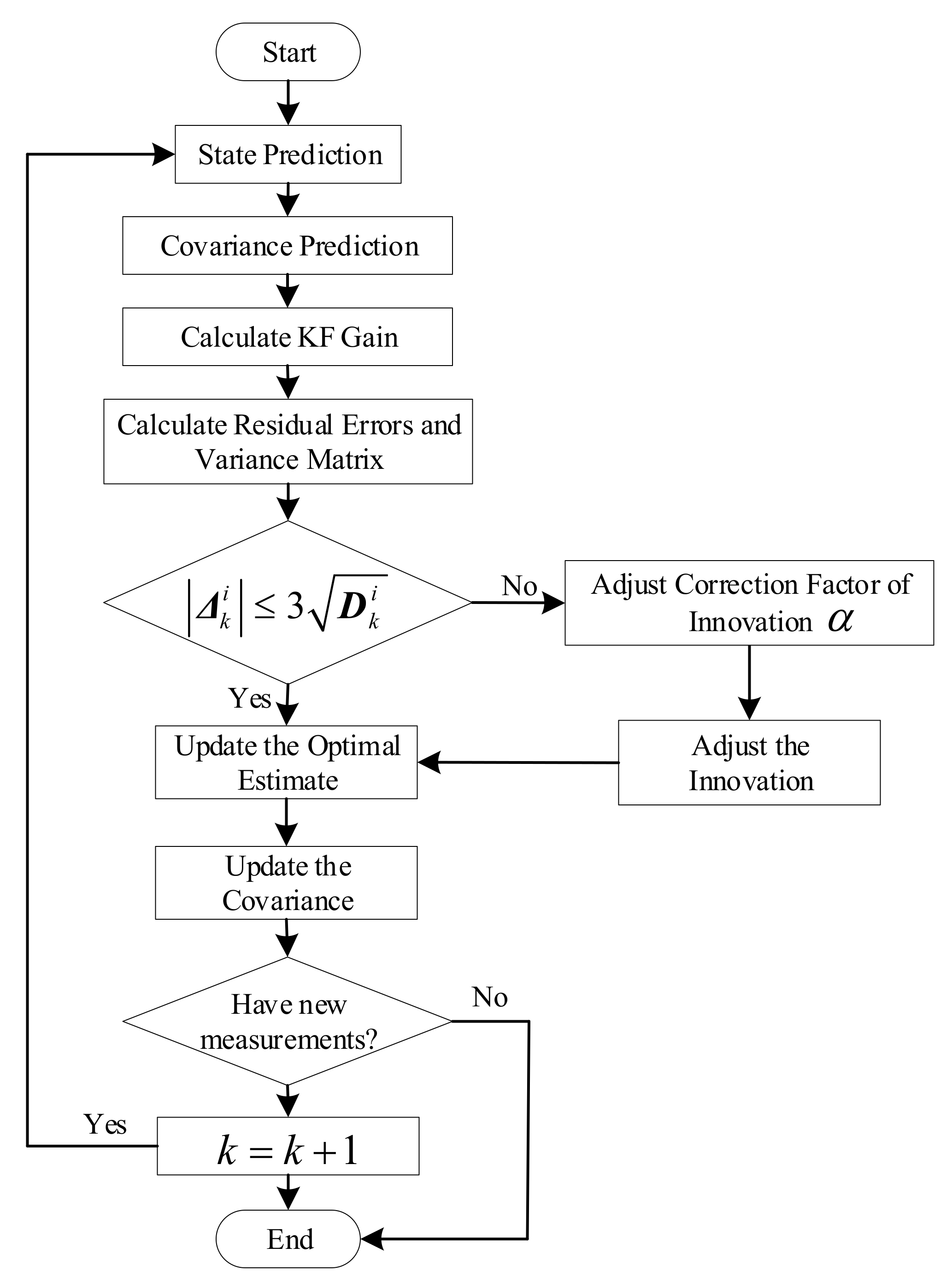
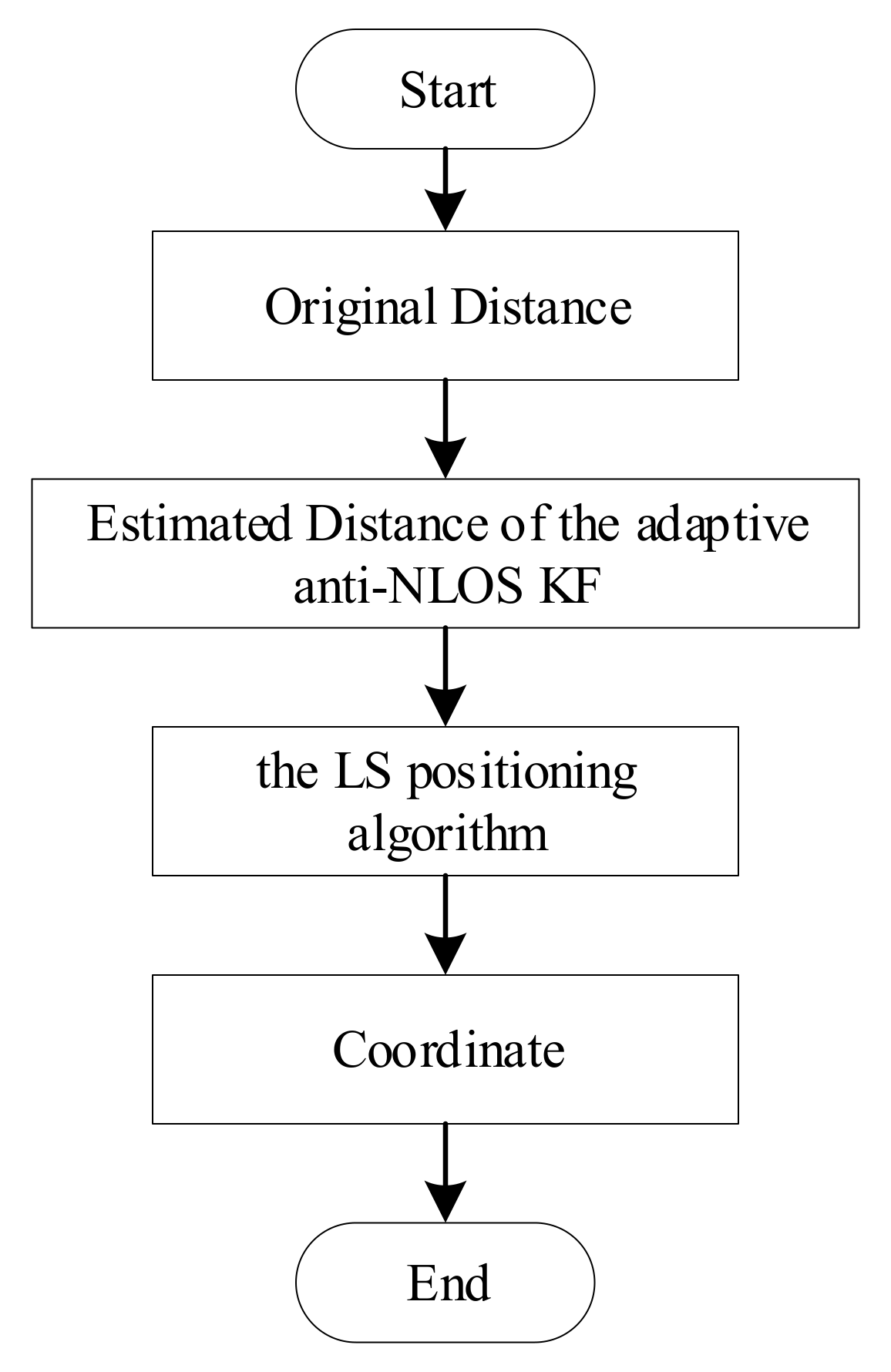


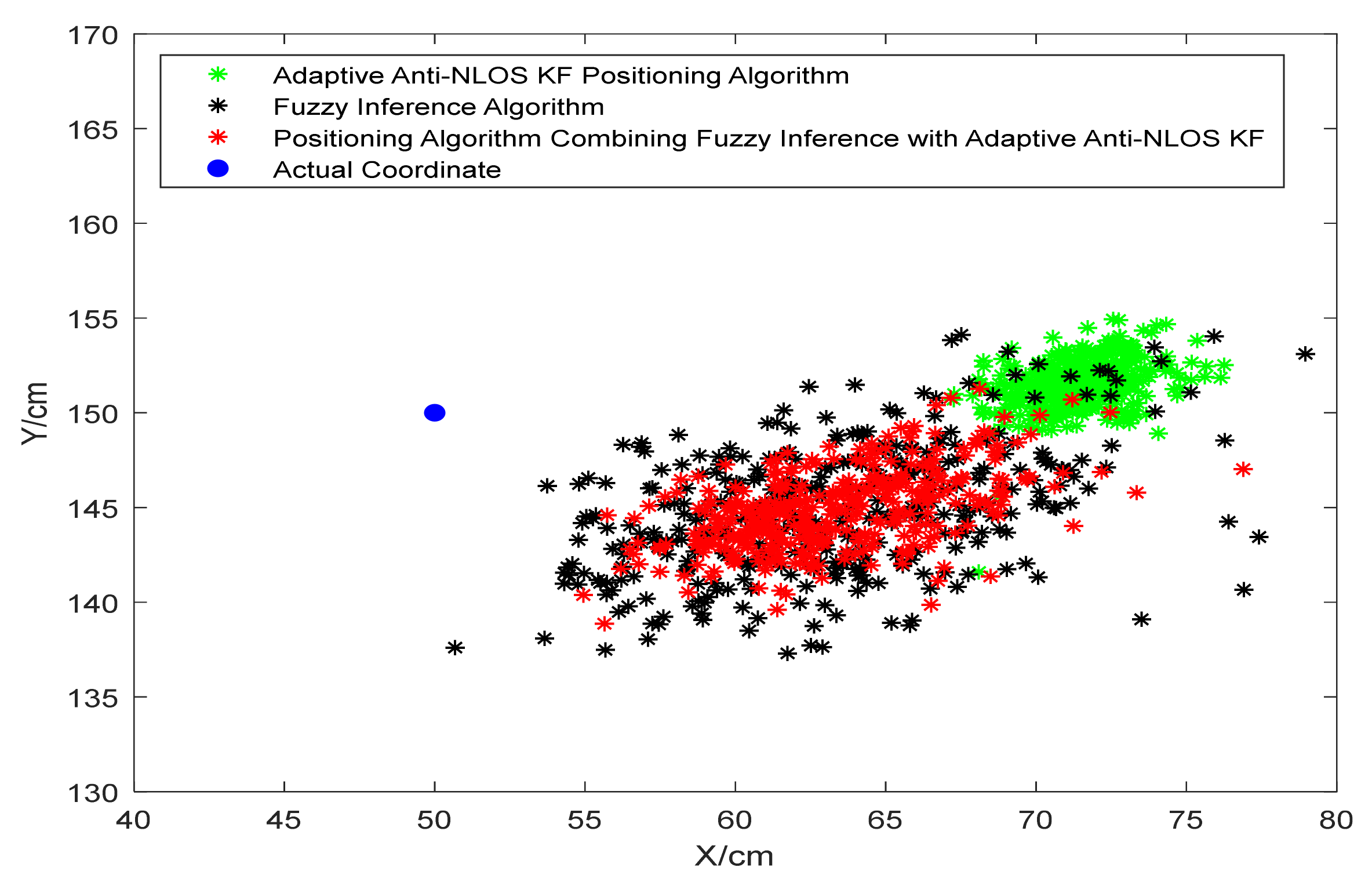


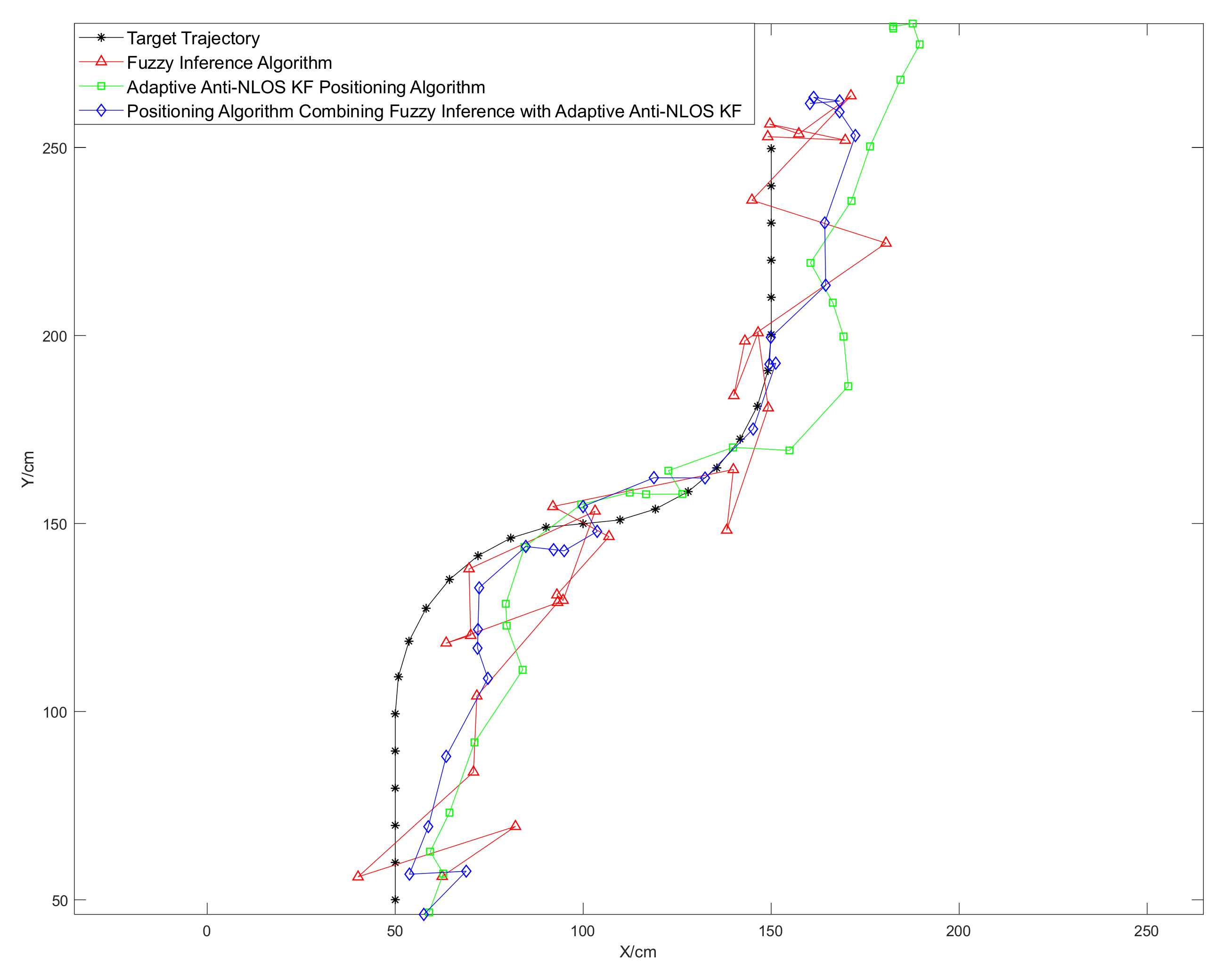
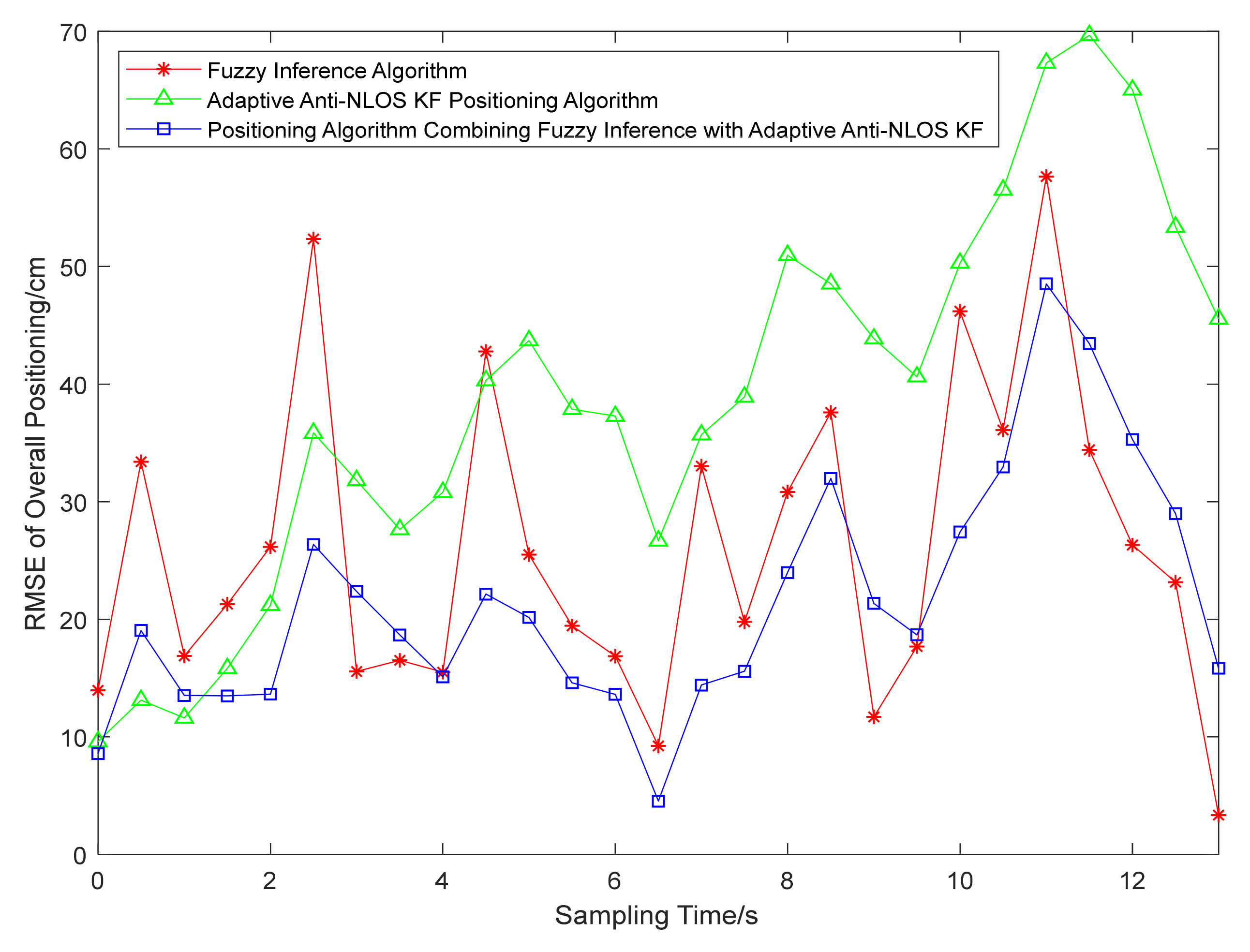
| RSSI | FPPL | RT | Range Error | |
|---|---|---|---|---|
| 1 | very large | very large | extremely small | very small |
| 2 | very large | very large | very small | very small |
| 3 | very large | large | extremely small | very small |
| 4 | very large | large | very small | very small |
| 5 | very large | medium | extremely small | small |
| 6 | very large | small | large | small |
| 7 | large | very large | extremely small | small |
| 8 | large | large | extremely small | small |
| 9 | large | large | very small | small |
| 10 | large | medium | small | small |
| 11 | large | extremely small | small | small |
| 12 | large | very small | small | small |
| 13 | large | very small | medium | medium |
| 14 | large | medium | extremely small | medium |
| 15 | large | medium | very small | medium |
| 16 | medium | small | small | medium |
| 17 | medium | small | medium | medium |
| 18 | very large | medium | small | large |
| 19 | very large | small | small | large |
| 20 | large | small | small | large |
| 21 | medium | very small | medium | large |
| 22 | small | small | small | large |
| 23 | small | small | large | large |
| 24 | very large | very small | large | very large |
| 25 | small | very small | large | very large |
| Positioning Algorithm | (50, 150) | (50, 175) | (50, 200) | (75, 200) | (100, 200) |
|---|---|---|---|---|---|
| Adaptive Anti-NLOS KF Positioning Algorithm | 21.5767 | 29.6724 | 28.3351 | 12.8494 | 29.5745 |
| Fuzzy Inference Algorithm | 15.5637 | 19.4664 | 28.5161 | 14.5265 | 16.7417 |
| Positioning Algorithm Combining Fuzzy Inference with Adaptive Anti-NLOS KF | 14.8205 | 19.1152 | 25.2317 | 12.8007 | 15.1546 |
| Positioning Algorithm | X Direction RMSE (cm) | Y Direction RMSE (cm) | Overall Positioning RMSE (cm) |
|---|---|---|---|
| Adaptive Anti-NLOS KF Positioning Algorithm | 29.6038 | 29.8749 | 42.0582 |
| Fuzzy Inference Algorithm | 20.0713 | 21.1351 | 29.1471 |
| Positioning Algorithm Combining Fuzzy Inference with Adaptive Anti-NLOS KF | 15.1454 | 18.4096 | 23.8390 |
Publisher’s Note: MDPI stays neutral with regard to jurisdictional claims in published maps and institutional affiliations. |
© 2022 by the authors. Licensee MDPI, Basel, Switzerland. This article is an open access article distributed under the terms and conditions of the Creative Commons Attribution (CC BY) license (https://creativecommons.org/licenses/by/4.0/).
Share and Cite
Wu, J.; Zhang, Z.; Zhang, S.; Kuang, Z.; Zhang, L. UWB Positioning Algorithm Based on Fuzzy Inference and Adaptive Anti-NLOS Kalman Filtering. Appl. Sci. 2022, 12, 6183. https://doi.org/10.3390/app12126183
Wu J, Zhang Z, Zhang S, Kuang Z, Zhang L. UWB Positioning Algorithm Based on Fuzzy Inference and Adaptive Anti-NLOS Kalman Filtering. Applied Sciences. 2022; 12(12):6183. https://doi.org/10.3390/app12126183
Chicago/Turabian StyleWu, Junkang, Zuqiong Zhang, Shenglan Zhang, Zhenwu Kuang, and Lieping Zhang. 2022. "UWB Positioning Algorithm Based on Fuzzy Inference and Adaptive Anti-NLOS Kalman Filtering" Applied Sciences 12, no. 12: 6183. https://doi.org/10.3390/app12126183
APA StyleWu, J., Zhang, Z., Zhang, S., Kuang, Z., & Zhang, L. (2022). UWB Positioning Algorithm Based on Fuzzy Inference and Adaptive Anti-NLOS Kalman Filtering. Applied Sciences, 12(12), 6183. https://doi.org/10.3390/app12126183






